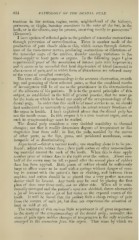Page 824 - My FlipBook
P. 824
834 PATHOLOGY OF THE DENTAL PULP.
tractions in tiie rectum, vagina, testes, neighborhood of the kidneys,
perineum, or thighs, burning sensations in the soles of the feet, in the
heels, or in the elbows, may be present, occurring mostly in paroxysms"
(Ziemssen).
I have spoken of reflected pain as the product of muscular contractions
through perversion of nerve-function. There is another mode of the
production of pain closely akin to this, which occurs through disturb-
ance of the vaso-motor nerves, producing contractions or dilatations of
the muscular coats of the arteries, thereby causing variations in the
blood-supply to local parts or organs. In the following pages I give
experimental proof of the association of intense pain with hypersemia;
and it seems to be conceded that local deprivation of blood (ansemia) is
also a cause of pain, and to which form of disturbance are referred many
of the types of so-called neuralgia.
The true office of symptomatology is the accurate observation, record-
ing, and grouping of these reflected pains, so that the combined results
of investigators will be of use to the practitioner in the determination
of the ailments of his patients. It is to the general principles of this
subject, as established in the field of general practice, that we must go
for the basis on which to found our study of the symptomatology of the
dental pujp. In order that this shall be of most service to us, we should
first understand as accurately as possible the actual sensory functions of
the organ in health. I have explained above that the dental pulp has
not the tactile sense. In this respect it is a true internal organ, and as
such its symptomatology must be studied.
The dental pulp manifests a very decided sensibility to thermal
changes ; not that it readily determines degrees of temperature or dis-
tinguishes heat from cold ; in fact, the pulji, unaided by the nerves
of other parts, as the lips, gums, and peridental membrane, seems
incapable of so discriminating.
Experiment.—Select a normal tooth ; one standing alone is to be pre-
ferred ; adjust the rubber dam ; then pack cotton or other non-conduct-
ing material around the neck of the tooth. When this is done apply
another piece of rubber dam to the tooth over the cotton. About one-
half of the crown may be left exposed after the second piece of rubber
dam has been applied. Both pieces of rubber should be sufficiently
large to allow water to be used with a syringe without danger of com-
ing in contact with the patient's face or clothing, and between them
napkins and cotton should be so placed that a very perfect non-con-
ductor shall be formed. Any tooth may be used by placing the first
piece of dam over three teeth, one on either side. When all is satis-
factorily arranged and the patient's eyes are shielded, throw alternately
a jet of ice-water and a jet of hot water on the exposed crown of the
tooth. It will be found that the patient feels a sharp twinge of pain
from the contact of each jet, but does not experience the sensation of
heat or cold at all.
The teaching of this curious little experiment is of great importance
in the study of the symptomatology of the dental pulp ; normally, this
sense of pain upon sudden changes of temperature is the only sensation
conveyed to the sensorium from this organ. That sense by which we


